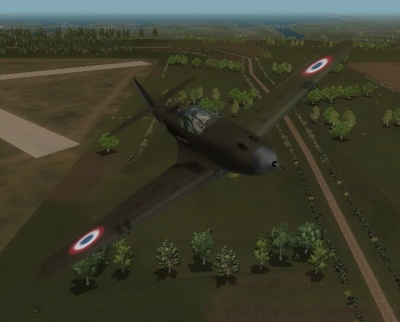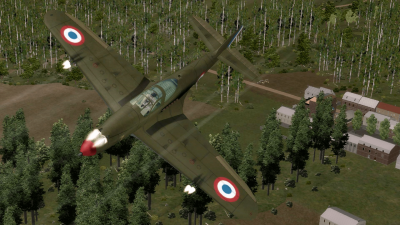Bell Model 14a / P39
Bell Model 14a / P-400 Airacobra
History
The Bell 14A was the first export version of the P-39 Airacobra. A mid-engine design and quick controls gave the P-39 a fairly unstable flight profile and earned it a reputation as a hot ship with a quick temper. While anemic at higher altitudes, it was very fast in low level flight and almost unmatchable in a dive. A centerline 20mm cannon was specified for the export P-400s but American issue and lend lease P-39s were equipped with a 37mm cannon, two .50 cal guns mounted in the cowling with four .30 cal guns in the wings, the Iron Dog could handle enemy aircraft, but its handling quirks proved too much for many USAAF combat pilots. This limerick was penned by USAAF fighter pilots early in the Airacobra's deployment:
"Don't give me a P-39
The engine is mounted behind
She'll tumble & spin
& she'll auger you in
Don't give me a P-39"
The French government had ordered P-39s in 1940, but they were not delivered due to the German occupation. But after French North Africa had sided with the Allies, P-39s were issued to French units where - unsurprisingly - they also failed to become popular. However, its bad reputation did not accompany the P-39 to Russia, whose pilots embraced it without reserve. Russian pilots found the P-39 an excellent platform for fighting the very same German aircraft in the very same manner as American and British pilots had deemed it incapable for - on the deck and turning - and the highest scoring Russian pilots racked up impressive tallies in it.
Gameplay
The P-39 has the potential to do very well, though, as is the case with all aircraft that displays certain quirks, it requires a highly disciplined pilot at the stick.
The Iron Dog has several challenging disadvantages: it is directionally unstable along its longitudinal axis through most of its operating speeds; it has a poor sustained turn rate and radius; it has poor stall behaviour that forces the pilot to fly benignly and predictably in a situation where it is likely to be the least profitable; it is a slow climber and does not perform very well above 7 km altitude. Beginner pilots especially must be very careful about using the highly sensitive rudder at all, at any speed or atittude, and even consummate pilots find the P-39s yaw performance a trifle troubling.
On the credit side, it is clean and fast airframe when allowed to run loose without elevator pressure, its rate of roll is excellent and it has a good field of view all around and especially over its tail. These benefits, in addition to a powerful armament, combine to make it a decent energy fighter, particularly when flown with a wingman or in a flight of four aircraft enjoying voice communication to make the most of their teamwork.
It is as a Close Air Support fighter however that it makes the biggest impact. Its fuselage mounted 200 kg bomb is powerful enough to scrap the heaviest enemy tank and after it has been expended, the P-39 carries a lot of ammunition for strafing purposes. The fuselage mounted twin .50 HMGs can dismantle light tanks and armored carn just as well as the centerline 20 mm AP-firing Hispano cannon, and with four .30 machineguns in the wings it can deliver a swathe of death.
Coming out of a dive at low altitude there is nothing that can catch the Iron Dog unless the pilot sheds his energy by manoeuvering. However, if a Bf 109-F or G, or a FW 190, happens onto a P-39 with energy to spare, the P-39 pilot is in a world of hurt and must tread lightly yet decisively to extricate himself. The way to deal with the P-39 in a close quarters scrap is to use its roll performance without hauling back too forcefully on the elevators but to time lag rolls and rolling scissors manoeuvres with immaculate care – and use every near head-on situation for unloaded extensions (i.e. neutralize the stick and accelerate away).
The generally popular heavy handed style of hauling the plane around in the tightest possible circles will get you either dead or in a lot of trouble, and that usually means dead. Consider the P-39 to be the antithesis of the Hawk 75 or Dewoitine 520. The P-39 is comfortably faster than the early version Bf 109-E’s, and you can out roll the later model Bf 109-F's in addition to being marginally faster on the deck at extremely low altitude. The P-39 can catch a FW 190 given a slight energy advantage but not outrun it nor out-accelerate it from a level starting point.
The P-39 is an excellent gun-and-run platform, either for bombing or for air superiority purposes. As long as you avoid prolonged turning, and stay away from any manoeuvres at all at stall speed, the Iron Dawg will be faithfully yours.
Model 26 / P-39N Airacobra
History
The P-39 Airacobra, although disappointing in many respects from its promised performance, was continually upgraded and modified to remain viable. The N version received a new engine and a propeller upgrade to improve its altitude performance. It remained very fast in low to mid level flight and remained practically untouchable in a dive. With a single centerline mounted 37 mm cannon, and two .50 cal machineguns in the cowling, plus four .303 cal guns in the wings, the Iron Dog carried more than enough firepower to handle a dogfight, but its delicate performance regime proved difficult to handle for the ham-fisted.
Gameplay
Stay high and fast in the combat zone and do not attempt to mix it up with 109s unless you have plenty of friendly company. Classic boom-and-zoom tactics on the 'One Pass, Haul Ass' principle, and the usual Drag-and-Bag ploy, will make the most of this fast and heavily armed crate. Be advised though that the 37 mm 37 mm Oldsmobile cannon with its slow rate of fire is a close-range weapon - you will have to close to near-collision distance and manually insert your shells with perfect precision! You stand a good chance against the Fw 190 if the fight is kept to the fast rolling style of fight, but be warned that heavy maneuvering is not the Iron Dog's strong point.
| Air Units in Battleground Europe | |
|---|---|
| Fighters and fighter bombers | |
| Bf 109E-1 | Bf 109E-4| Bf 109E-4B |Bf 109F-2 | Bf 109F-4 | Bf 109G-2/R1| Bf 109G-6/U4 | Bf 110C-4 | Bf 110C-4/B | Blenheim IF | Dewoitine D.520 | Fw 190A-3B | Fw 190A-4 | Hawk 75 | Hawk 81 | Hawk 87 | P-40F Kittyhawk Fighter Bomber | | Hurricane Mk I | Hurricane Mk IIb | Hurricane Mk IIc | Hurricane Mk IID | Junkers 87G2 'Stuka' | P-38 'Lightning' | Bell Model 14a / P-400 Airacobra | Model 26 / P-39N Airacobra | Spitfire Mk Ia | Spitfire Mk IIb | Spitfire Mk Vb | Spitfire Mk IXc | |
| Bombers | |
| Blenheim IV | Douglas DB-7 | Havoc Mk.I | A20C Havoc | Heinkel 111 | Junkers Ju 88A4 | Junkers 87 'Stuka' | | |
| Transport | |
| C47 'Skytrain' | Junkers 52 | |

